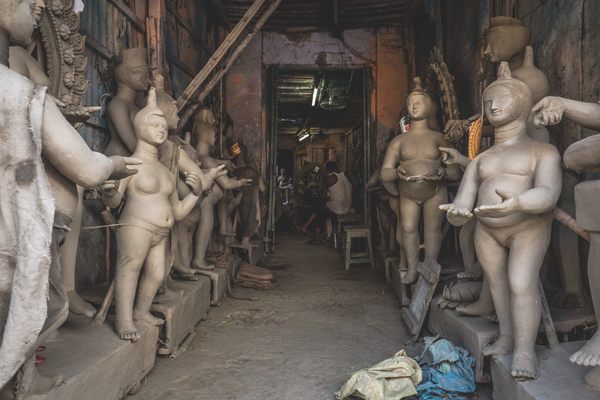AO Edited
Katra Masjid
This 18th-century complex has served as a mosque, mausoleum, and one of the largest caravanserais in India.
In his 1785 book Select Views in India, the English artist William Hodges described Katra Masjid as a grand seminary of Muslim learning. He traveled to Murshidabad in 1781 and painted the mosque with its two huge octagonal minarets and five domes, part of a six-year trip throughout India. Today, the mosque looks a little different; With the ravages of time and the great earthquake of 1897, two of its domes have been destroyed.
Constructed in 1724 by Murshid Kuli Khan, this red burnt brick-built quadrangle Katra Masjid served multiple purposes. It was a caravanserai, a mosque, and a mausoleum. The place is no longer used for prayers, but back in the day the small rooms around the mosque were used by those who read the Quran and the large courtyard in the mosque was used to offer namaz (prayers).
According to historians, the word katra refers to caravanserai (roadside inn) in Arabic and Persian. Katra Masjid was the largest caravanserai in the Indian subcontinent, built during the era when Bengal was a major hub of trade in Eurasia. Traders flocked to Bengal for silk, jute, and muslin.
Katra Masjid is also a mausoleum of its creator, Murshid Kuli Khan, whose remains are interred below the staircase of the entrance. According to historians, Khan, the first Nawab Nazim or the ruler of Bengal, Bihar, and Orissa between 1717 to 1727 and the emperor who established the town of Murshidabad wanted to be buried under a mosque’s staircase as a mark of humility.
Khan died on June 30, 1727. Popular belief holds that he wanted to be buried this way as a mark of repentance, as it is said that Khan built the mosque using materials obtained upon destroying several Hindu temples and residences. He believed every time a person who would climb the stairs to reach the mosque would cross over his body, their footsteps dust would help cleanse his sin. However, this theory of looting Hindu shrines hardly holds any ground because the mosque shows the uniformity of material and the Nawab was a known patron of many Hindu temples including the neighboring Radha Madhab temple of Kumarpara.
The mosque has two inscriptions on basalt slabs. The Persian inscribed slab says that this mosque was constructed by Nawab Nazim Murshid Quli Khan, while the Arabic inscription reads: “Muhammad, the Arabian, is the glory of both worlds. Dust be on the head of him who is not the dust of his portal.”
According to local stories, Murshid Quli was also known as Jaffer Khan Jinda Pir, or the living saint. It was believed that cholera would never break in the vicinity of this sacred building through his blessings and benedictions. Today, the mosque is maintained by the Archaeological Society of India.





















Follow us on Twitter to get the latest on the world's hidden wonders.
Like us on Facebook to get the latest on the world's hidden wonders.
Follow us on Twitter Like us on Facebook